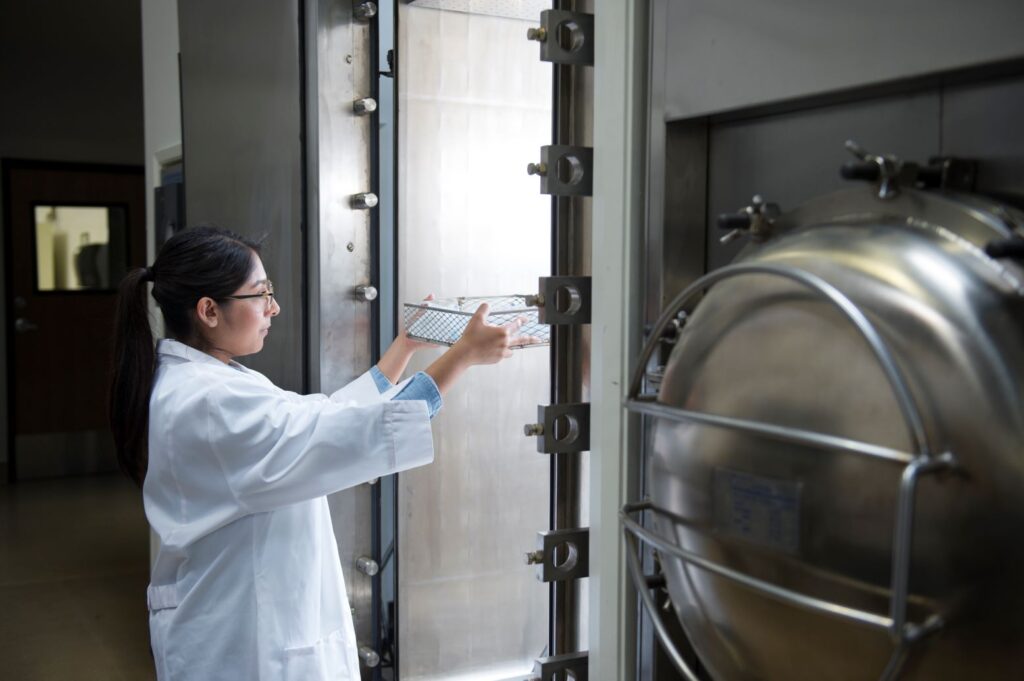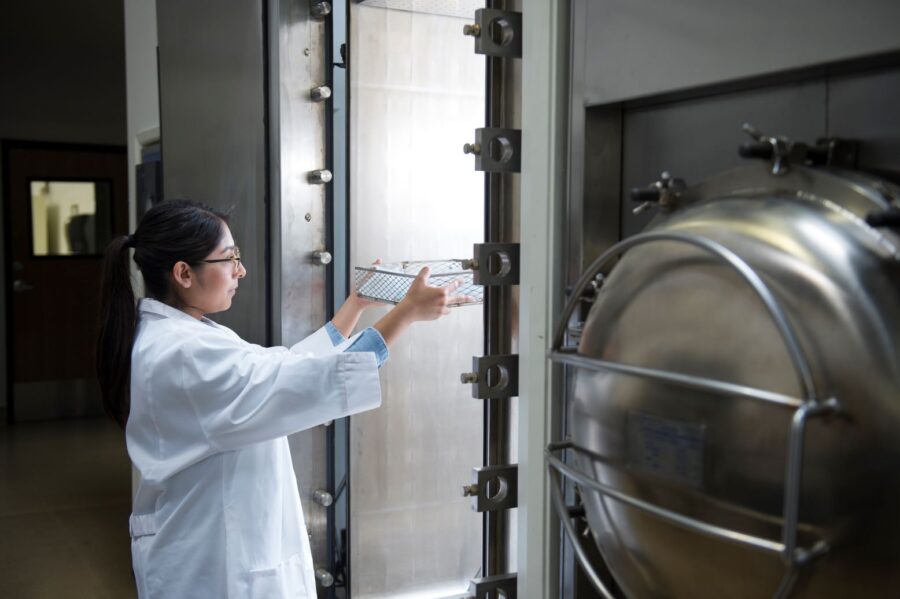Did you know that autoclaves, first invented in 1879, have become an indispensable tool in modern medicine, and one of the most used methods for sterilization in hospitals around the world?
In the field of medical device packaging in particular, understanding this process is crucial for ensuring the safety and efficacy of medical devices. This article will explore the importance of autoclave sterilization, its ins and outs, and how it impacts the medical device industry, especially in terms of packaging, assembly, and sterilization.
What is Autoclave Sterilization?
Autoclave sterilization is a cornerstone of modern medical practices. It’s a method used to kill or eliminate harmful microorganisms such as bacteria, viruses, and spores from medical devices and other materials, and involves subjecting these items to high-pressure saturated steam at elevated temperatures. It’s designed to meet rigorous sterilization standards, such as those outlined by the Centers for Disease Control and Prevention (CDC), which recommend sterilization temperatures between 121-132 degrees Celsius.
The concept is relatively simple but highly effective: The combination of steam and pressure, when applied correctly, ensures that even the most resilient forms of bacteria and spores are destroyed, making the sterilized items safe for medical use.
Autoclave Sterilization in Medical Device Packaging
The global medical device market, valued at approximately $512.29 billion in 2022, is expected to grow annually, with sterilization playing a key role in this expansion.
And while autoclave sterilization is used in various industries, for the purpose of this article, we’ll focus mainly on its application in the medical device industry.
In this industry, sterilization is not just about the devices themselves but also about how they are packaged. The packaging needs to maintain the sterility of the device from the point of sterilization until it reaches the end user, typically a healthcare professional or patient. If the packaging is compromised at any stage, the sterility of the device inside may be at risk, which can lead to serious health implications.
For instance, a surgical instrument that is not properly sterilized can introduce infections into a patient’s body during a procedure. Therefore, the packaging must be designed to endure the autoclave process without melting, tearing, or otherwise losing its integrity, while also being easy to open in a sterile environment. It must be robust enough to protect the contents during transportation and storage, yet amenable to the sterilization process.
This dual requirement leads to the development of specialized packaging materials and designs that can withstand high temperatures and pressures without degrading or compromising the sterility of a device.
During assembly, each of the medical device’s components must be sterilized to prevent contamination when they come together to form the final product. Besides that, medical instruments like scalpels, syringes, and catheters are frequently exposed to autoclave sterilization to make sure they’re germ-free when they touch your body during medical procedures.
However, autoclave sterilization is not limited to the medical device industry; it finds applications in various sectors, including pharmaceuticals, research laboratories, and food processing.
Step-by-step process of autoclave sterilization
The autoclave itself is a specialized machine designed for sterilization. It features a sealed chamber where items to be sterilized are placed. The autoclave uses high-pressure and superheated steam to create a controlled environment, and this meticulous process involves several critical steps to ensure the complete elimination of all microorganisms.
Here’s a detailed look at each step:
Procedures and Phases of Sterilization
- Cleaning: The first and perhaps most crucial step is cleaning. All devices and their components must be thoroughly cleaned to remove any organic matter or residue. This is important because any remaining debris can protect microorganisms from the lethal effects of the steam and pressure.
- Packing and Loading: After cleaning, the items are packed in materials that can withstand the autoclave’s conditions. This packaging is designed to allow steam penetration while maintaining the sterility of the contents. The items are then carefully loaded into the autoclave, ensuring that there is enough space for steam to circulate around each item.
- Sterilization Cycle: Once the autoclave is sealed, the sterilization cycle begins. The machine uses superheated steam with correlating high pressure to reach temperatures much higher than boiling water, typically around 121-134 degrees Celsius (250-273 degrees Fahrenheit). This high temperature, combined with the pressure and steam, is maintained for a specific duration, usually 15-30 minutes, depending on the nature of the items being sterilized.
- Monitoring: Throughout the sterilization process, monitoring the autoclave’s temperature and pressure is essential. This ensures that the conditions are optimal for sterilization throughout the entire cycle.
- Cooling and Drying: After the sterilization cycle is complete, the chamber is slowly depressurized and the items inside need to be cooled and dried in order to avoid any remaining moisture.
- Unloading and Storage: Once the cycle is complete and the items have cooled, they are carefully removed from the autoclave. They must be stored in a dust-free environment, away from physical hazards to maintain their sterility until they are ready for use.
Advantages and Limitations of Using Autoclave Sterilization
According to the World Health Organization, sterilization of medical instruments is a vital process in preventing healthcare-associated infections, with autoclaves being one of the most commonly used sterilization methods worldwide. It’s certainly not surprising that autoclaves are so prevalent, given their effectiveness.
- High Efficacy: First and foremost, autoclaves are highly effective at destroying all types of microorganisms, including bacteria, viruses, and even the most resistant spores. This level of efficacy is essential for meeting the stringent sterility standards required in medical settings.
- Versatility: Autoclaves can sterilize a wide range of instruments and materials, including surgical tools, laboratory equipment, and certain types of plastics, making them versatile tools in various healthcare and research settings.
- Speed: Compared to other sterilization methods, autoclaves can process items relatively quickly, usually within 15 to 30 minutes. This is especially important in environments where a rapid turnaround of sterile equipment is needed.
- Safety and Reliability: When operated correctly, autoclaves are safe and reliable. They come with safety features designed to prevent accidents, and their consistent performance ensures a dependable sterilization process.
- Non-Toxic: Unlike some sterilization methods that rely on chemicals, autoclaving uses only steam and pressure, making it a non-toxic option that doesn’t leave harmful residues on instruments.
- Cost-Effectiveness: In the long run, autoclaves are cost-effective. They require minimal consumables other than water and energy, and their durability means they can be a one-time investment for many years.
In comparison to other sterilization methods like ethylene oxide (EtO) sterilization, autoclaves are faster and do not require aeration time, making them more suitable for rapid turnaround needs.
However, there are also some limitations that need to be considered:
- Quality Control: The effectiveness of sterilization depends on the proper operation of the autoclave, including the correct setting of time and temperature. Regular validation is necessary to ensure it consistently reaches the required parameters, which often involves biological indicators or chemical indicators.
- Resource Intensive: While autoclaves are highly effective, they are also resource-intensive, requiring significant amounts of energy and water. That’s why there is a push in the industry to make these devices more efficient, which includes developing autoclaves that use less water and energy, as well as exploring alternative sterilization methods that have a lower environmental footprint.
- Packaging and Storage: Post-sterilization, the items must be handled correctly to maintain sterility. That includes proper packaging and storage, which can be challenging in busy or resource-limited settings.
- Material Limitations: While autoclaves can sterilize a lot of different materials, some can’t withstand the high temperatures and pressure of autoclave sterilization. Certain plastics, heat-sensitive materials, and electronic components may be damaged or degraded in the process. For instance, polyethylene, a common plastic used in medical devices, can start to soften at temperatures as low as 115 degrees Celsius, well below the standard autoclave temperatures.
- Training and Safety: Above all, operating an autoclave requires specific training and adherence to safety protocols. The high pressure and temperatures involved can be hazardous, and operators must be trained in proper usage and safety measures.

Future Trends and Innovations in Autoclave Sterilization: Implications for Medical Device Packaging and Assembly
As we look towards the future, the evolution of autoclave sterilization technology is set to play a pivotal role in the medical device packaging and assembly industry, particularly for companies like Pro-Tech Design.
One key area of development is the creation of more energy-efficient autoclave models. This advancement is not only crucial for reducing power consumption but also aligns with the sustainability goals of forward-thinking companies.
The integration of advanced materials and smart technologies, such as IoT and data analytics, is another exciting prospect. They will not only streamline the sterilization process but also provide critical data to optimize operations and ensure compliance with health standards.
As we continue to witness advancements in autoclave technology, staying informed and adaptable is crucial for those in the medical device packaging and assembly industry. We encourage readers to explore these developments and consider how they can be applied to enhance sterilization processes in their own operations.
In the meantime, don’t hesitate to reach out if you need any information about the autoclave or any other sterilization process. For additional resources, feel free to check out our blog or leave us a question in the comments below.
Summary
- Autoclave sterilization is a vital method in modern medicine for eliminating harmful microorganisms from medical devices and materials.
- Packaging plays a crucial role in maintaining sterility from sterilization to end-user, leading to the development of specialized packaging materials.
- The step-by-step process of autoclave sterilization involves cleaning, packing, sterilization cycle, monitoring, cooling, and unloading.
- Advantages of autoclave sterilization include high efficacy, versatility, speed, safety, reliability, and cost-effectiveness.
- Limitations include the need for quality control, resource intensity, packaging and storage challenges, material limitations, and safety considerations.
- Future trends in autoclave sterilization include energy-efficient models, integration of advanced materials and smart technologies, and a focus on sustainability.
- Staying informed and adaptable to advancements in autoclave technology is crucial for the medical device packaging and assembly industry.

